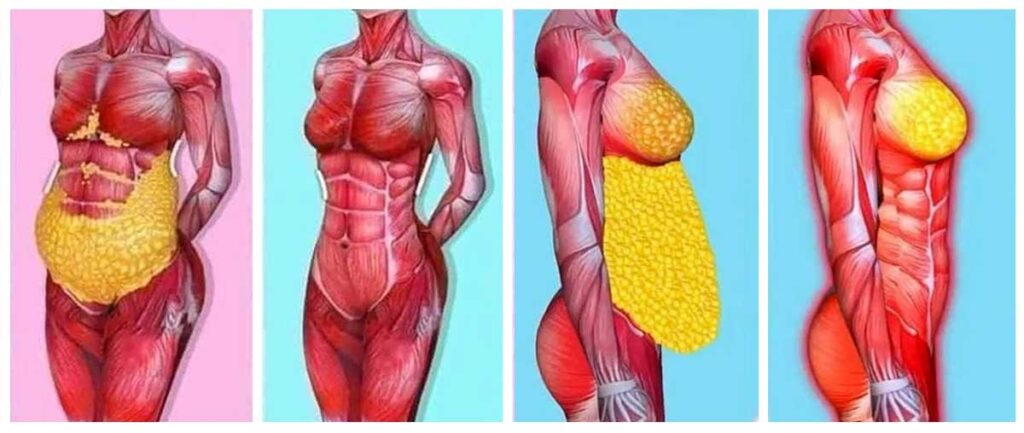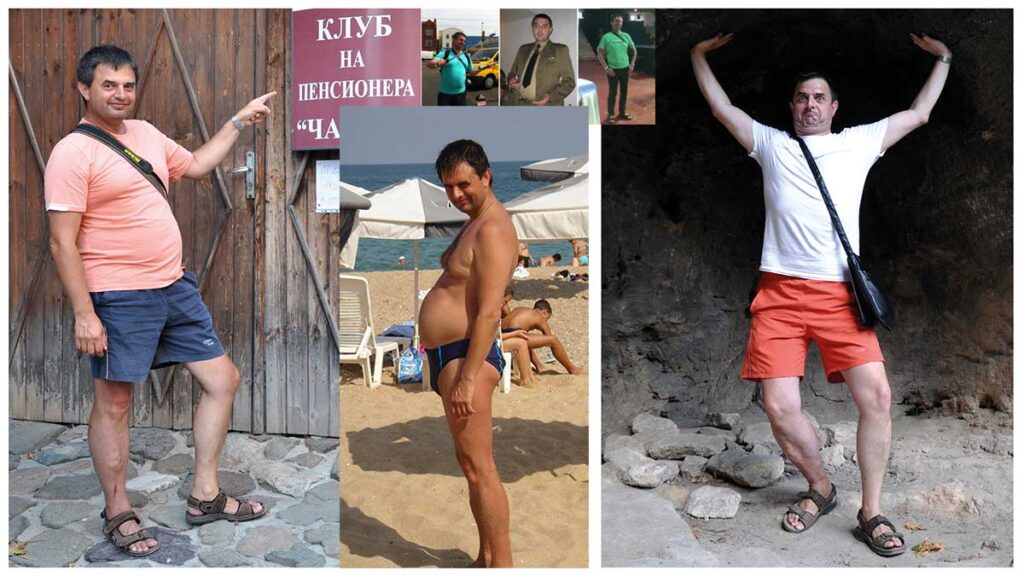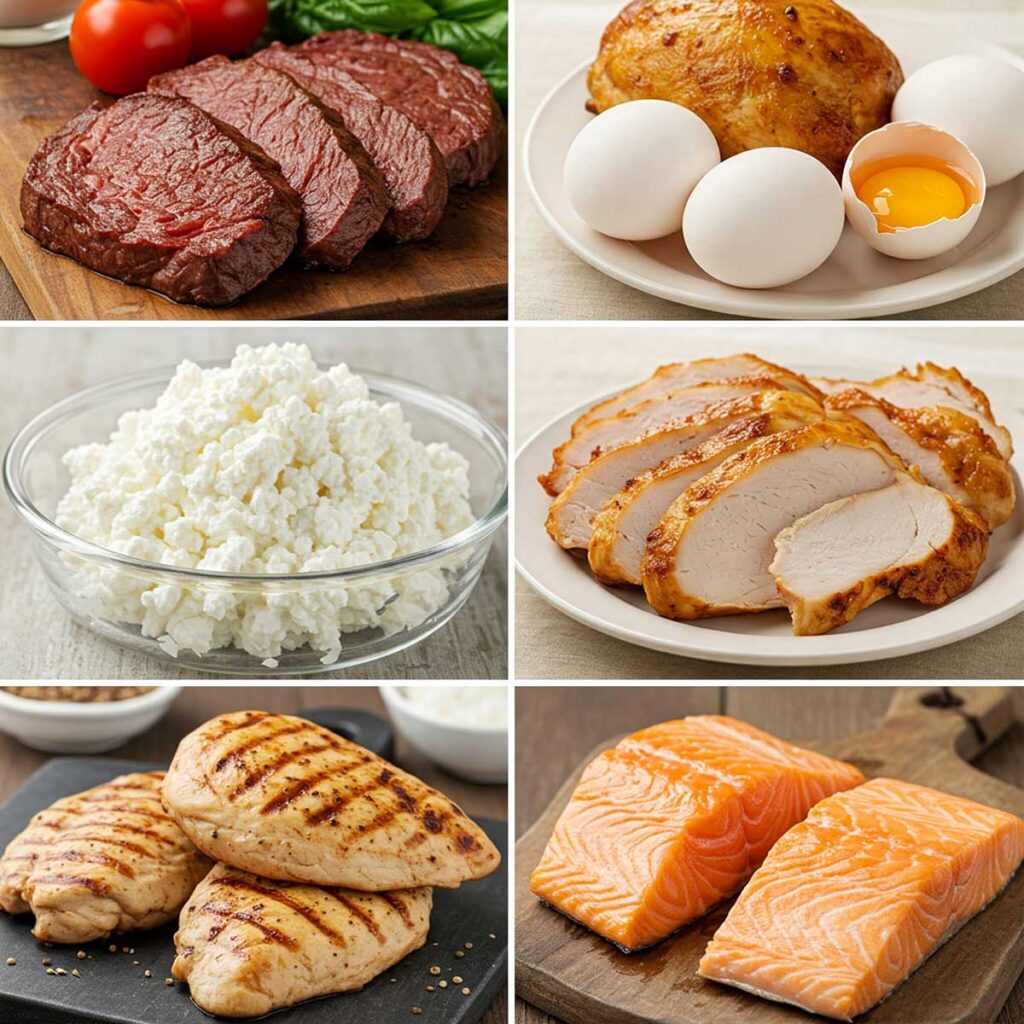
7 Steps to a Life Without Visceral Fat
7 Steps to a Life Without Visceral Fat
(and why we should care!)
Visceral fat… just sounds scary, right? And rightly so! Unlike those subcutaneous “sweet nuggets” that we can pinch (and often hate), visceral, or internal, fat is much more insidious. They surround our vital organs and instead of just sitting there, they actively disrupt our hormonal balance and slowly but surely undermine our health.
I know, I know, it’s not the most positive start, but believe me, there is light at the end of the tunnel! The good news is that we can get rid of these unwanted “tenants” in our bodies. And even better – we can do it sensibly, without subjecting ourselves to excruciating diets and endless cardio, which often only lead us to despair.
In the following lines, we will take a closer look at why visceral fat is so dangerous, how to find out if we have excess of it (without having to go for an MRI), and most importantly – we will draw up a step-by-step working plan on how to “exorcise” it from our body within about 30 days.
7 steps to a life without visceral fat (and why we should care!).
Of course, the final result depends on your dedication, but these steps are easy to follow and I myself have used them to lose over 30 kilograms, much of which was visceral fat.
What exactly is visceral fat and why is it so “bad”?
Imagine it as an invisible layer of fat that “wraps” around your internal organs in the abdominal area. In small amounts, it performs a protective function, but when it accumulates in excess, it becomes a real “parasite”. And the worst thing is that it does not stand idly by, but actively affects our entire body.

What is visceral fat
Visual fat is a small “chemical factory” that constantly produces harmful substances called cytokines. These cytokines cause chronic inflammation throughout the body – like a smoldering fire that never goes out. Visceral fat is a real toxic plague that “poisons” organs, damages blood vessels and disrupts the delicate hormonal balance.
A large amount of visceral fat turns our body into a “breeding ground” for all kinds of diseases and weakens our immune system. As we age, the risk of heart attack and stroke increases sharply, as inflamed arteries become more easily clogged or narrowed. Insulin sensitivity drops dramatically, bringing us dangerously close to type 2 diabetes. Testosterone in men (and women to a lesser extent) decreases, which leads to a loss of energy, motivation, makes it difficult to build muscle mass, and metabolism worsens.
Studies have even linked visceral fat to an increased risk of certain types of cancer, dementia, liver disease, and other serious health problems.
“But I’m thin, so I’m OK, right?”
You’re wrong!
Even if you’re one of those people who fits into size S clothes, this is no guarantee that you don’t have excess visceral fat. There are people who look thin on the outside, but are “full” of this insidious fat on the inside. We call them “thin on the outside, fat on the inside.”
The lack of excess weight does not automatically mean that you are protected. We have had cases where people with a perfect figure, measurements of a bioimpedance analyzer for body composition showed alarmingly high levels of visceral fat. And what’s worse, this large amount of internal fat often does not give any external signs until it leads to a serious health problem. That’s why we call them “silent killers.”
The truth is that many people, not just men, underestimate or simply don’t realize this danger.
Visceral fat doesn’t just take up space and damage organs. It actively “steals” our energy. We wake up tired, even after a good night’s sleep. We feel irritable and in a bad mood all day for no apparent reason. If we try to exercise, our workouts are sluggish and ineffective. Even our libido can suffer. This fat seems to suck our life force without us even noticing how it’s happening. That’s why it’s important to strive for a life without visceral fat.
But before we rush to the nearest gym, we need to understand something very important. This is where many people overestimate the gym and make a mistake. There’s no way to get rid of visceral fat with physical exertion alone. Cardio alone rarely solves the problem. Even if it helps, we often have to reduce subcutaneous and total fat to almost a minimum in order for the body to start “reaching” for internal fat. And this can take years of hard work. It won’t happen in 30 days.
Internal fat is not just a matter of training. It is a matter of a complete lifestyle.
The positive thing is that the sooner we realize this, the sooner we can take measures. And that’s exactly what I want to show you in the next steps.
How do we “get” this toxic layer around our organs?
The short answer is – because of our lifestyle.
The long answer, however, requires a little more explanation. Most people, often unconsciously, create ideal conditions for the accumulation of internal fat every day. And first of all, here is our diet.
It’s not just about eating too much (although that can be a factor). The problem is what exactly we’re eating.
Highly processed foods, sugary snacks, beer and other alcoholic beverages… all “delicacy” that we find hard to resist. Unfortunately, these products cause a sharp increase in insulin and “switch” our bodies into fat storage mode, especially in the abdominal area, around the stomach and other important organs.
The next “culprit” is training (or rather, the lack of it or its improper execution). Many people avoid any physical activity. But there are also those who supposedly train regularly, but still have excess visceral fat. Why?
Often the reason is the wrong approach. For example, endless cardio without strength training can lead to muscle loss, slowing down metabolism and even greater accumulation of visceral fat in the long run. Especially if the training is not supported by enough protein.
Let’s not forget one of the main “players” here – stress. Stress is like a magnet for visceral fat. Why? Because stress releases the hormone cortisol. When cortisol levels are high, it’s like “pouring gasoline on the fire” of visceral fat. And often, when we’re stressed, our entire diet goes to hell. We don’t even realize we’ve eaten a whole pizza. The reason? Cortisol again. And if you’re under constant stress – at work, at home – guess what, your body is in constant mode of accumulating visceral fat.
And this inevitably leads to the next big problem – insufficient sleep.

The Pyramid of Healthy Living (en translation)
As children in school, we were shown a healthy life as a pie chart with three equal parts – movement, nutrition and sleep. But as we get older, we understand that this should be a pyramid, the base of which is sleep, then nutrition and at the top – movement. Sleep is the foundation. If we don’t get enough sleep, our body falls into chaos. Hunger hormones rise sharply, the desire for unhealthy foods increases, and our ability to burn fat decreases. And on top of that, poor sleep also increases cortisol levels – a double whammy!
And what do we often do to “calm down”? We reach for alcohol. Alcohol is “liquid sugar” with serious side effects. It stops the body’s ability to process excess fat, as the liver is busy “neutralizing” it. Especially beer. No matter how much we reassure ourselves that it contains beneficial substances, beer is like a direct “pouring” of fat into the abdominal area. And for men, there’s an added “bonus” – beer increases estrogen levels. The most masculine drink makes you… less masculine in a certain aspect.
Finally, something that is often overlooked – age. After the age of 30, testosterone levels naturally begin to decline. And low testosterone is a “red carpet” for visceral fat. If we don’t take measures – we don’t exercise and don’t eat right – this fat will accumulate at an ever-increasing pace.
Here’s the balance: if we eat “junk”, move little, get angry a lot, sleep little and poorly, drink often and allow our hormones to decrease without fighting it – we get the perfect “cocktail” for visceral fat, instead of building a life without visceral fat.
I understand that so far it sounds quite discouraging. But let’s move on to the good news – all of this is fixable!

Age is not a vice!
In the next section, we will find out how to assess whether we have excess visceral fat, and then we will look at specific steps on how to deal with it.
How to find out how much visceral fat we have?
Most people think that if they don’t have a big belly, then they don’t have visceral fat. Unfortunately, this is not always the case. The most accurate way to measure visceral fat is through a DEXA scan, MRI or CT scan. But let’s be realistic – we are unlikely to sign up for such tests just because someone on the Internet told us that they are dangerous.
Therefore, there are simpler, although not as accurate, but perfectly acceptable methods. One of them is the waist test. Take a tailor’s tape measure and measure the circumference of your waist (about four fingers above your belly button). If you are a man and your waist is over 102 cm, this is a signal of a problem. For women, this limit is 88 cm.
A more accurate option is the waist-to-height ratio. Your waist circumference should be less than half your height. For example, if you are 180 cm tall, your waist should be under 90 cm.
Body shape itself can also be an indicator. If your belly is protruding, stretched, and hard, somewhat resembling a bowling pin, this is a classic sign of increased visceral fat. If your belly is softer and the skin is not as stretched, you probably have more subcutaneous fat.
Another easy and fairly reliable indicator is constant lack of energy, chronic fatigue, and a constant desire for sleep and sweets. This is often a sign of increased visceral fat.
Finally, if you have regular preventive checkups, pay attention to your indicators. High blood pressure, high cholesterol, pre-diabetes, or insulin resistance often go hand in hand with increased visceral fat, even if you are not overweight.
Visceral fat is like a poisonous gas – invisible, silent, and deadly.
Now that we know how to assess whether we have excess internal fat, let’s see how to deal with it.
7 steps to permanently “burn” visceral fat
Most people approach this problem wrong. They either starve themselves, or undergo drastic diets, or spend hours on the treadmill. Visceral fat requires a smarter and more sustainable approach.
Here is a working action plan for a life without visceral fat, without unnecessary complications:
Step 1: Balanced and sensible eating, not starvation.
We don’t need another “miracle” diet with hundreds of prohibitions. We just need to eat in a way that doesn’t allow the body to accumulate fat, but on the contrary, stimulates it to burn it. The easiest way to eat sensibly is to emphasize protein and fiber, while minimizing processed foods.

Foods rich in protein (proteins)
Here is a list of the foods in the image with the approximate protein content in 100 g of the product:
- Veal (roasted): about 25-30 g of protein
- Turkey (roasted, white): about 30 g of protein
- Eggs (boiled): about 13 g protein
- Quadra: about 11 g protein
- Chicken (roasted, white): about 30 g protein
- Fish (salmon, baked): about 25 g protein
Please note that these values are approximate and may vary depending on the specific type of product and the method of preparation.
- Protein fills us up, maintains and increases muscle mass and speeds up metabolism. Make sure that each meal contains a source of protein (meat, fish, eggs, dairy products, legumes).
- Fiber also fills us up without adding many calories and aids digestion. Include plenty of vegetables and fruits in your diet. It doesn’t matter if they are fresh or frozen, eat them with main meals or as snacks.
- Carbohydrates are not the enemy! Choose complex carbohydrates (potatoes, rice, oats, whole grains) and limit simple carbohydrates and sugar (pasta, sugary drinks, desserts, processed foods). Try to avoid added sugar for at least 30 days.
It is important not to feel too limited. Use the 80/20 rule – eat healthy 80% of the time and allow yourself your favorite foods the other 20%.
Step 2: Strength training at least 3 times a week.
Forget about the idea of ”burning” maximum calories during training. Our main goal should be building muscle mass. The more muscle we have, the faster our metabolism will be and we will burn more calories even at rest.

Building Muscle Mass
A note for ladies: Don’t worry about becoming “muscular” and “masculine”. The female body has a different hormonal balance and this is very difficult to achieve without special supplements. Strength training will help you become leaner, stronger, and have a faster metabolism for a life without visceral fat.
It is recommended to visit a gym (or train at home with weights) at least three times a week. Focus on compound exercises that engage multiple muscle groups at once (e.g. squats, deadlifts, push-ups, pull-ups, barbell/dumbbell rows, bench press). Pay more attention to correct execution of the exercises than to the weight. Start with lighter weights to master the technique, and gradually increase the load. Aim for weights and a number of repetitions that are challenging but allow you to maintain good form.
Step 3: Exercise every day – walk more!
Walking is often underestimated, but it is an extremely effective means of burning internal fat and improving overall health.

Exercise every day
Why is it so important? Walking reduces stress, lowers cortisol levels, speeds up metabolism and helps directly burn visceral fat without putting unnecessary strain on the body.
The average person today takes between 3,000 and 5,000 steps per day. Try to increase this number to 8,000-10,000 steps per day. This can burn an extra 300-400 calories per day just from walking! It’s not that difficult – it can often be achieved with a little more than an hour of walking. Walking is the simplest form of cardio and does not cause the brutal hunger that often occurs after an intense run.
Step 4: Get enough and quality sleep – as if your life depends on it (because it largely does!).
We have already mentioned that sleep is the base of the health pyramid. When we don’t get enough sleep, our body increases cortisol levels and decreases testosterone levels – again “pouring gasoline on the fire” of visceral fat.

Get enough and quality sleep
Aim for at least 7-8 hours of sleep per night. If you have trouble sleeping, try improving your sleep quality:
- Completely darken your bedroom. Make it as dark as possible.
- Maintain a cool temperature in the room (around 18 degrees Celsius).
- Avoid screens (phones, tablets, TVs) at least 30 minutes before bed.
Step 5: Manage stress effectively.
Of course, we can’t always avoid stressful situations. But we can learn how to react to them and how to reduce chronic stress, which is a real “damager” of health and a “lover” of visceral fat.

Manage Stress Effectively
You don’t have to meditate for an hour a day (unless you like it). Here are some simple but effective techniques:
- A 10-minute walk in the fresh air every day. Without a phone, just enjoy nature and breathe. Try breathing through your nose – it calms your nervous system.
- Take magnesium (remember to follow the recommended daily dose). It helps reduce cortisol levels and relaxes your muscles.
- Try binaural beats. Search the internet for “binaural beats” and experiment with different melodies and frequencies. It may sound strange, but many people find it helps them relax.
Step 6: Limit (or temporarily stop) alcohol.
We’re not saying never drink again. But if you’re seriously motivated to lose belly fat fast, it’s best to cut out alcohol completely for at least the next 30 days.

Limit (and if possible – temporarily stop) alcohol
Alcohol worsens sleep quality, lowers testosterone levels, and prevents the body from burning fat, as the liver is busy processing it. In short – alcohol is a great “partner” of visceral fat.
There is also an unexpected bonus – you will save money and avoid some unwise decisions that we often make under its influence (both in nutrition and in other aspects).
Step 7: Be consistent, but don’t strive for perfection.
You are human, and there will be days when you don’t stick to your plan 100%. It’s important to get back on track as soon as possible – the very next day, not waiting for “Monday”, the end of the holidays, or next year. Success is not achieved by those who never make mistakes, but by those who learn from their mistakes and move on.
I know it’s easy to say, but trust me, you will be pleasantly surprised by the results you can achieve in just 30 days if you implement these steps to a life without visceral fat.

Be consistent, but don’t strive for perfectionism
And it’s not just about visceral fat anymore. It’s about your confidence, energy, sleep quality, relationships with loved ones, and even your bank account (you’ll spend less on junk food and alcohol). Taking care of yourself and your health is the best investment in the future.
In conclusion, let’s summarize the main steps:
- Balanced and sensible nutrition: More protein and fiber, limited simple carbohydrates and sugar.
- Strength training: At least 3 times a week, focusing on complex exercises and proper technique.
- Daily exercise: Aim for 8,000-10,000 steps per day.
- Quality sleep: 7-8 hours a night in a dark and cool room, no screens before bed.
- Stress management: Walks, breathing, magnesium, binaural beats.
- Limit alcohol: If possible, stop completely for the first 30 days.
- Consistency, but not no Perfectionism: Return to the plan after every “deviation”, without fear of mistakes.

Easy steps to a life without visceral fat
Take care of yourself, pay attention to your body and strive to be the best version of yourself.
You deserve to live your life without visceral fat!
You deserve to live your best life!
Bibliography:
Regarding visceral fat and its impact:
Smith, G. I., Mittendorfer, B. (2016). Visceral adipose tissue: a critical regulator of metabolic disease. Best Practice & Research Clinical Endocrinology & Metabolism, 30(5), 511-521.
Klopfenstein, A. M., Forster, A., Rohner-Jeanrenaud, F. (2012). Brain insulin resistance: linking the brain to obesity and type 2 diabetes. Physiological Reviews, 92(4), 1441-1473.
Regarding nutrition:
Willett, W.C. (2012). Nutritional epidemiology. Oxford University Press.
Anderson, J.W., et al. (1991). Health implications of dietary fiber. Nutrition Reviews, 49(1), 1-18.
Regarding physical activity:
Garber, C.E., et al. (2011). Quantity and quality of exercise for developing and maintaining cardiorespiratory, musculoskeletal, and neuromotor fitness in apparently healthy adults: guidance for prescribing exercise. Medicine & Science in Sports & Exercise, 43(7), 1334-1359.
Regarding sleep:
Walker, M. P. (2017). Why we sleep: Unlocking the power of sleep and dreams. Scribner.
Regarding stress:
McEwen, B. S. (2007). Physiology and neurobiology of stress and adaptation: central role of the brain. Physiological Reviews, 87(3), 873-904.
Regarding alcohol:
Piano, M.R. (2017). Alcohol’s impact on the cardiovascular system: a review. Alcohol Research: Current Reviews, 38(2), 219.



